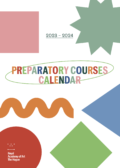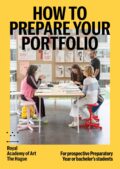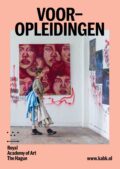The Preparatory Year at the Royal Academy of Art, The Hague (KABK) focuses on learning how to conceptualise experiences and observations. You will also develop an appropriate attitude towards work, which will serve you well during your later studies at an art academy. The Preparatory Year demands your complete dedication and requires active participation.
Structure of the programme
The curriculum consists of a diverse range of classes taught by teachers affiliated with the KABK. The courses offered include Raw Reality (observing and processing the world around you), Theory in Practice (observing and processing the art world), Time/Space/Audience and Work groups. These courses focus on communication skills and the capacity to transform experiences and observations into images. There is an emphasis on the study attitudes and mentality that are needed to study at an art academy.
The year is divided into three periods:
This period is characterised by a broad orientation and includes assignments with a wide scope, leaving space for individual interpretations and approaches. During the first period, you will be exposed to a wide range of cultural expressions through viewing exhibitions and films, and learning how to formulate reactions to these. Included in the first period are subscriptions to the Filmhuis and theatres of the National Theatre. The study programme demands full-time effort, autonomy and active participation.
After the first period, you will choose the directions you wish to pursue further. As a result, the second period, which runs from January through March, has a more individual character and focuses more specifically on a particular subject area. Students are brought into contact with the bachelor department of choice at the KABK.
The third part of the programme consists of six weeks, starting from early April, during which you will work in the bachelor departments you have chosen, preparing yourself for the admissions procedure that will follow in late May.
As the above overview shows, this programme has a tiered structure. Customised curriculums are possible, in consultation, provided that the overall range of education allows for this. It is also possible to work in a variety of workshops, subject to the procedures and rules that apply there.
Courses
Taught by: Amber Beernink, Jonathan Looman
Taught by: Amber Beernink, Jonathan Looman and Kim Nuijen
Taught by: Lena Shafir and Joncquil de Vries
Taught by: Zanne Zwart, Gosse de Kort and Maartje Lammers
Taught by: Zuzanna Zgierska and Floris Kruidenberg
Taught by: David Galjaard
Workspace/studios & materials
You are advised to create your own workspaces/studios at home so that you can work at your own pace, with a sufficient variety of materials at hand.
The materials that are required are specified for each course. The KABK has an art supply shop, where materials may be purchased; materials can also be obtained at the KABK workshops. A variety of equipment can be rented for a small fee. The ultimate cost of materials depends on your individual choices and ideas and will vary by student.
Presentation days and assessments
There are five presentation days throughout the year and three assessment moments. Two assessments, in December and March, are teachers meetings followed by the results for every student individually in the system Osiris. Results are visible for every student individually after logging in. The last assessment is the Final assessment at the end of May. This final assessment forms the basis for a report, which also constitutes a certificate of participation for the year. Not presenting during this final assessment means no certificate. The second presentation involves representatives of the various bachelor departments.
Independence
Personal effort and group dynamics are of crucial importance during the preparatory year. Teachers give assignments and you go from there by yourself. So take it upon yourself, do a lot of your own research. When you have interest for materials en disciplines you investigate further what this means. Make contact with students. The visual possibilities to express are very broad; teachers show various possibilities, but the actual research is your own.
We expect minimally one cultural visit per week. Also it is crucial to keep a personal archive. In this archive you include your cultural visits, including your personal reaction (in text and image), you put interesting news articles / photos / artists / artworks. For your information and inspiration. The focus of the year is authenticity and concept. A common misunderstanding is that this should be closely related to perfect control of techniques.
For general education and cultural reference the curriculum already includes various, mandatory visits. This is a first incentive, we expect the student to be committed to these visits, with an open, curious attitude also undertaking cultural visits by own initiative.


